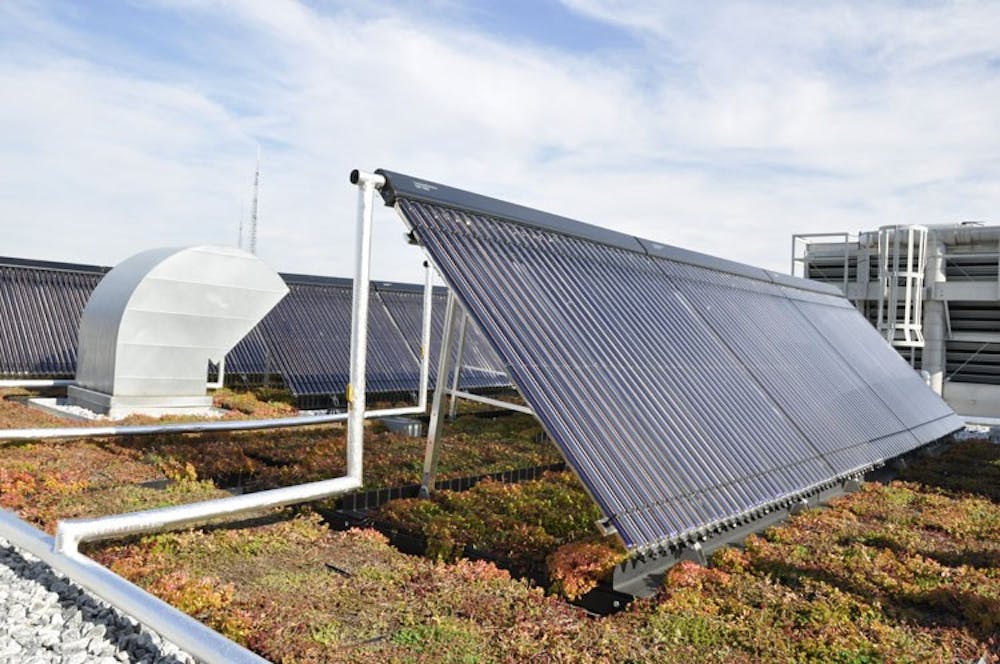Correction appended
AU will house the largest solar hot water system on the East Coast by the end of this week.
The Office of Sustainability has been installing 2,150 solar photovoltaic panels and 134 racks of thermal energy panels on the roofs of Mary Graydon Center and Letts, Anderson and Centennial Halls since June. All of the units will be operational this week.
The solar hot water system will provide 70 to 80 percent of the hot water for the South Side residence halls and MGC, according to Joshua Kaplan, Office of Sustainability outreach specialist.
The photovoltaic panels will supply 15 to 20 percent of MGC’s energy, or enough to power the Tavern.
“This installation is a key step in our plan for carbon-neutrality,” Office of Sustainability Director Chris O’Brien said. “We want to help localize renewable energy production as much as possible,”
AU’s installation of solar and energy panels will help the University become carbon-neutral by 2020. The University has been buying carbon offsets and renewable energy credits for 100 percent of AU's electricity since 2010, according to Kaplan.
The solar hot water system is 75 to 85 percent efficient in converting the sun’s energy into heat for water. Solar panels are only 11 to 12 percent efficient in converting this energy, though technology is improving, O’Brien said.
AU has already installed solar panels on various other buildings to provide energy.
With the addition of the solar hot water system, AU has run out of buildings to house solar panels and/or thermal energy racks due to roof space and quality constraints, according to Kaplan.
The solar panels are plugged into the energy grid for the buildings. The thermal energy panels plug directly into the domestic hot water systems, according to Facilities Management staff member Ray Leary. They will help provide all hot water used in MGC and South Side for sinks and showers, except TDR dishwashers. The dishwashers require higher-temperature water than the solar-heated water attains, according to Leary.
“This has no effect on the quality of the water or energy provided, we’re just changing the source,” Kaplan said.
O’Brien: Universities should lead the way in sustainability
A similar, yet smaller, solar hot water system was installed at George Washington University last spring.
Kaplan is proud that AU can be recognized as having the biggest solar hot water system on the East Coast, but he is glad other schools are taking steps toward a greater end goal.
“When it comes to new technology, we’re always looking for ways to distinguish ourselves, which is great, but from a sustainability standpoint it’s good for others to have it as well,” he said.
O’Brien said he believes it’s necessary for universities to lead the way in eco-friendly technology.
“It’s important to show that higher education is leading and serving as a model of green technology,” O’Brien said. “If the best and the brightest people, what a University has, can’t lead on climate change, there is a big problem.”
Eco-Sense President and College of Arts and Sciences senior Scott Berman said he’s happy about the solar hot water system installation, though he hopes more people learn about the system in the future.
Financing for the project
The project was financed through purchasing power agreements with Washington Gas and Electric and Skyline Innovations.
The systems are installed and maintained at no cost to the University for their contract’s duration, 20 years with the option for renewal, according to Kaplan.
AU pays a fixed percentage of the energy savings to the provider, around 60 to 70 percent, according to Sandra Lee, a spokeswoman for Skyline Innnovations, the company who installed and will maintain the solar hot water heating system. Using this plan, AU instantly saves money from the installation instead of having to wait for a return on the investment, overcoming the traditional barrier to using such technology.
Skyline Innovations, a D.C.-based company, finances these installations through revenue from installations’ solar credits, which they own during the contract, and tax incentives, in addition to AU’s payments.
Numbers on AU’s total energy savings with the installation of solar energy panels are not yet available, according to Leary.
A previous version of this article stated that the Office of Sustainability will install 2,150 solar photovoltaic panels and 134 racks of thermal energy panels this week. The University has been installing the panels since June, but all panels went online this week. The article also did not clarify that the photovoltaic panels, not the thermal energy panels, will supply 15 to 20 percent of the energy MGC uses. It also stated that AU has been buying renewable energy credits since 2010, but the University has been buying renewable energy credits longer than that and has been buying RECs for 100 percent of AU electricity since 2010.





